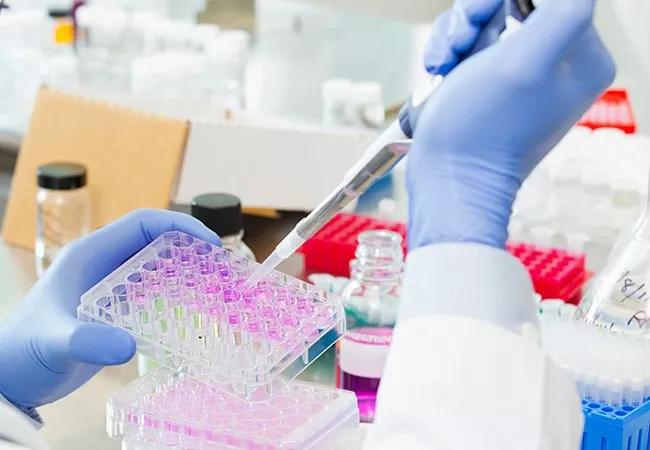Noninvasive aspiration to test for cytokines enhances our understanding of the pathophysiology of endometriosis

One-quarter to one-half of all women who are infertile have endometriosis, as do up to one-half of those who have pelvic pain. Surgery is the gold standard for assessment, but in part because it is invasive, definitive diagnosis is often delayed as long as 8-10 years.
Advertisement
Cleveland Clinic is a non-profit academic medical center. Advertising on our site helps support our mission. We do not endorse non-Cleveland Clinic products or services. Policy
Cleveland Clinic researchers have found that aspiration of endometrial fluid for analysis of cytokines may be an effective way to evaluate women with pain or infertility for advanced endometriosis.
In a small study, researchers observed that a combination of interleukin (IL)-1α, IL-1β and IL-6 in endometrial secretions was predictive of stage 3 and 4 endometriosis (with the area under the receiver operating curves [ROC] being 0.78). Published in the Journal of Assisted Reproduction and Genetics, the study showed that a threshold value of 118 pg/mL yielded a sensitivity of 75% and a specificity of 70% for the diagnosis of advanced endometriosis.
“A lot of previous work has been dedicated to identifying a biomarker for endometriosis in serum, urine or endometrial tissue that would reduce the long delay to diagnosis,” says Natalia C Llarena, MD, first author of the paper. “The advantage of aspiration of endometrial fluid is that it requires only insertion of an embryo transfer catheter, which is essentially painless. Additionally, there is already literature suggesting that valuable data can be obtained from such secretions obtained prior to in vitro fertilization.”
In addition to assessing levels of IL-1α, IL-1β and IL-6 in endometrial fluid, the investigators also looked at levels of IL-8, vascular endothelial growth factor (VEGF), tumor necrosis factor-α (TNF-α) and monocyte chemoattractant protein-1 (MPC-1). A multiplex immunoassay was used to quantify the cytokines and growth factors — all of which are known to play important roles in the pathogenesis of endometriosis.
Advertisement
The participants in the study were 60 women who were scheduled to undergo laparoscopic surgery for benign indications. Endometrial fluid was aspirated from them prior to the procedures, and staging was done during surgery using the American Society for Reproductive Medicine staging system for endometriosis. Logistic regression analysis was used to evaluate combinations of cytokines, and receiver operating curves were generated to evaluate the predictive capacity of the assay.
Analysis of cytokine levels according to endometriosis stage showed no significant differences between controls and patients with stage 1 and 2 endometriosis, whereas levels of IL-1α and IL-6 were significantly increased in the endometrial secretions of women with stage 3 and 4 disease. A more than twofold increase in levels of IL-1α was seen in women with advanced endometriosis versus controls, and levels of IL-6 were increased by nearly sixfold.
“We were disappointed to find that cytokine and growth factor levels in endometrial fluid were not predictive of stage 1 and 2 disease because it’s typically harder to identify lower stage endometriosis — which may still be quite debilitating for patients — using imaging and other noninvasive modalities. However, future work may provide the sensitivity to detect these variants of the disease,” says Elliott Richards, MD.
Overall, 22 women had no endometriotic lesions, 19 had stage 1 to 2 disease, and 19 had stage 3 to 4 endometriosis. Most patients with stage 1 to 2 endometriosis had peritoneal disease, whereas the phenotype of stage 3 to 4 disease varied. Of the women with advanced disease, 63% had endometriomas, 37% had complete posterior cul-de-sac obliteration, and 26% each had rectovaginal septum lesions, bowel or appendiceal lesions, or deep infiltrating lesions of the pelvic sidewall.
Advertisement
In a subgroup analysis to evaluate mean cytokine levels according to endometriosis stage and cycle phase, mean levels of IL-1α, IL-1β, and IL-6 were increased in stage 3 and 4 disease compared with controls in both the follicular and luteal phases. The differences did not, however, reach statistical significance.
Because this was a proof-of-concept study, the findings can’t be directly applied to clinical practice. However, the researchers believe that these data demonstrate the feasibility of endometrial fluid profiling for diagnosis of endometriosis. They are also pursuing avenues for the technique that are related to infertility.
Says Dr. Llarena, “This type of analysis may be a window into how endometriosis changes the endometrium and how the disease affects the endometrial environment. In the future, we are interested in looking at whether these cytokines and growth factors are predictive of success with fertility treatment in women with endometriosis.”
Advertisement
Advertisement

ACOG-informed guidance considers mothers and babies

Prolapse surgery need not automatically mean hysterectomy

Artesunate ointment shows promise as a non-surgical alternative

New guidelines update recommendations

Two blood tests improve risk in assessment after ovarian ultrasound

Recent research underscores association between BV and sexual activity

Psychological care can be a crucial component of medical treatment

A multidisciplinary approach facilitates timely diagnosis and better treatment